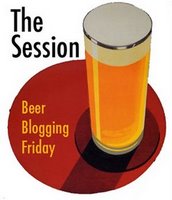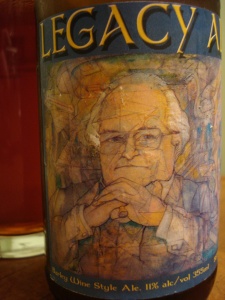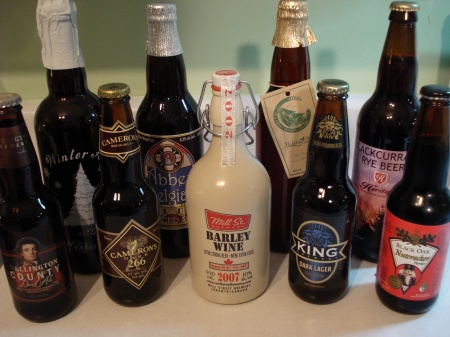This article was originally written in December 2006 for the now-defunct food and drink website Gremolata. It was re-published here in September 2011, but back-dated to appear in the blog archives close to its original publication date.
“Christmas time is here,
Time to drink some beer!
Give us ale, both dark and pale,
The best way to spread cheer!”
(with apologies to Charles Schultz & Vince Guaraldi)
While the holiday season is most often associated with mulled wine, rum & egg nog, and maybe wassail if you’re feeling particularly old-timey, there is also a great tradition of special beers being brewed for the colder months in general, and Christmas in particular. Usually stronger, darker and more flavourful than a brewery’s year-round beers, Christmas and winter beers can be found in pretty much any country that has a history of brewing. There’s even an annual Christmas beer festival in Belgium where more than 100 seasonal beers are served each year.
Here in Ontario, we have a more recent winter beer tradition in the form of the LCBO’s Winter Warmers promotion, which sees them bring together an assortment of strong beers from around the world each December, just in time for holiday enjoyment. This year’s selection is skewed heavily towards the UK, where the winter beers tend to be beefed up versions of classic ale styles, often augmented with spices or specialty malts and hops. Here are some notes on a half-dozen festive UK brews that are currently available in limited quantities at selected LCBO outlets:
Belhaven Wee Heavy ($3.10/500 mL, 6.5% abv, LCBO 698977)
Wee Heavy is a designation that been is use for a couple of centuries by Scottish brewers to refer to their strongest offerings. Analogous to England’s Barley Wine style, they are sometimes known as 90 Shilling (written 90/-) in reference to the usual invoice cost of a hogshead barrel of the style in the early 19th century. While some Wee Heavies can inch up towards the 10% abv mark, Belhaven’s version keeps the booze in check, making it much more quaffable. It features flavours of sweet malts, brown sugar & caramel, and a hint of smokiness joining the mellow hops in the finish.
Fuller’s Vintage Ale 2006 ($6.95/500 mL, 8.5% abv, LCBO 676213)
One of the highlights of each year’s Winter beer promotion is the arrival of the annual Fuller’s Vintage Ale. Brewed in limited quantities using a different recipe each year, these Barley Wine style ales are fine to drink right away, but also lend themselves to aging. Each bottle also comes in an embossed burgundy box, making it a great stocking stuffer for your favourite beer drinker. This year’s edition is a bright orange-amber ale with aroma of biscuits, sweet fruit, herbal hops and some alcohol dryness. The flavour is big and warm, like a classic English Pale Ale laced with a half-shot of smoky whisky. I suspect that it will improve with a bit of aging to mellow to boozy edges, but it’s still a fantastic sipper for a cold evening.
Greene King Strong Suffolk ($3.45/500 mL, 6.0% abv, LCBO 575530)
Greene King is one of England’s oldest breweries, and also one of the country’s largest thanks to a series of sometimes controversial buy-outs that it has undertaken in recent years. With Strong Suffolk, they go back to their roots, restoring the tradition of blended ales that was once quite common amongst breweries and publicans. This practice of mixing one beer with another was often employed as a means of using up older or spoiled beers by mixing them with younger, fresher stock, but it was also used for more legitimate reasons to produce quality products that customers enjoyed, such as the pub staple Black & Tan. In the case of the Strong Suffolk, they brew a 12% beer called Old 5X that is aged in oak vats for a minimum of two years, and then mix it a freshly brewed batch of a dark ale called BPA just before bottling. The result is a ruby-chestnut beer with a soft & sweet aroma, a smooth body that brings to mind a good cask ale, and a flavour that starts slow, but builds to include notes of sweet malt, raisins & prunes, and some slightly tart wood notes in the finish.
Samuel Smith Winter Welcome Ale ($3.95/550 mL, 6.0% abv, LCBO 408005)
Established in 1758, Samuel Smith is the oldest brewery in Yorkshire, and one of England’s oldest independent breweries. Their Winter Welcome is one of the best known UK seasonal beers throughout the world, and it is also one of the least traditional, as it is produced using artificial carbonation and is only available in filtered and pasteurized bottled form, whereas more traditional British ales are made available in more natural cask versions. Still, this is a pleasant amber ale, holding notes of caramel, mint, almonds and bread, along with the expected malt and hop characteristics. And since Samuel Smith has finally started shipping their beers in brown bottles rather than clear glass, you are now much less likely to find yourself with a lightstruck (aka “skunky”) pint when you open one of these.
St. Peter’s Winter Ale ($3.50/500 mL, 6.5% abv, LCBO 890079)
Known for their distinctive flask-like bottles, St. Peter’s brews ales that range from the traditional (Best Bitter, Old Style Porter, IPA) to the quirky (Cinnamon & Apple Ale, Lemon & Ginger Ale). Their winter ale falls into the former category, and is accurately described on the label as a “classic winter warmer”. It’s the darkest of the lot, pouring a deep, dark ruby-brown with a small tan head. As with the Strong Suffolk, it has a soft, cask-like body, which lends it even more of a traditional air. The aroma is roasty and smoky with notes of dark cherry and cocoa, and the flavour brings to mind an old style Porter, with strong chocolate, coffee and roasted malt notes, and a warming bitterness in the back of the throat.
Wychwood Bah Humbug ($3.25/500 mL, 6.0% abv, LCBO 3822)
Wychwood are the folks behind the popular Hobgoblin and Fiddler’s Elbow ales, as well as the nicely labelled but rather poor quality Black Wych Stout. Their seasonal Bah Humbug is a strong ale brewed with a healthy dose of cinnamon, and it comes through in both the aroma and flavour. The aroma also gives off notes of fruitcake, nutmeg, roasted malt, and a hint of chocolate, while the flavour is malty and fruity, some mild spice and banana bread coming through, followed by a faint hoppiness. It’s very nice stuff, but it’s also getting scarce already, as it hit the shelves a few weeks before the rest of the winter beers. Look around a bit and you be able to find a few bottles kicking around, but if you can’t, you’ve got the five previously mentioned beers to choose from, not to mention the rest of the winter release:
Chimay Blue ($3.20/330 mL, 9.0% abv, LCBO 357236)
De Koninck Amber Ale ($2.15/330 mL, 5.0% abv, LCBO 676882)
Innis & Gunn Limited Edition Oak-Aged Beer ($4.85/330 mL, 7.2% abv, LCBO 16337)
Okocim Porter ($2.45/330 mL, 8.3% abv, LCBO 340919)
Trafalgar Celebration Ale ($3.95/650 mL, 5.7% abv, LCBO 684878)
XO Beer ($3.95/330 mL, 8.0% abv, LCBO 527838)
Cheers, and Happy Holidays!
 How sad is this: I’m so late getting my post up for this month’s Session that not only did I miss the wrap-up post, but I also missed the post-wrap-up post. I guess this means that I don’t have to go into any great detail about the barley wine style in general, since several others have already a good job of it.
How sad is this: I’m so late getting my post up for this month’s Session that not only did I miss the wrap-up post, but I also missed the post-wrap-up post. I guess this means that I don’t have to go into any great detail about the barley wine style in general, since several others have already a good job of it. From the sounds of it, Williams left a pretty big legacy, so it’s fitting that he be remembered by a pretty big beer. It pours a very attractive ruby-orange with a small head that disappears quickly. The robust aroma has notes of sweet caramel malt, rum-soaked raisins, orange zest, and a warm and mellow hint of hops. The body is full and rich, and the flavour follows pretty closely on the aroma, starting quite smooth and sweet with dried fruit and caramel notes, and moving into a long, warm finish that reminds you this is an 11% ale. Over a year on from the December, 2006 bottling date, it’s in fine shape, although I’m sure if I had another couple of bottles to stash away, they’d fare well for at least a few more years, if not longer.
From the sounds of it, Williams left a pretty big legacy, so it’s fitting that he be remembered by a pretty big beer. It pours a very attractive ruby-orange with a small head that disappears quickly. The robust aroma has notes of sweet caramel malt, rum-soaked raisins, orange zest, and a warm and mellow hint of hops. The body is full and rich, and the flavour follows pretty closely on the aroma, starting quite smooth and sweet with dried fruit and caramel notes, and moving into a long, warm finish that reminds you this is an 11% ale. Over a year on from the December, 2006 bottling date, it’s in fine shape, although I’m sure if I had another couple of bottles to stash away, they’d fare well for at least a few more years, if not longer.
